

Ten trends to watch in the coming year. If 2021 was the year the world turned the tide against the pandemic, 2022 will be dominated by the need to adjust to new realities, both in areas reshaped by the crisis (the new world of work, the future of travel) and as deeper trends reassert themselves (the rise of China, accelerating climate change).
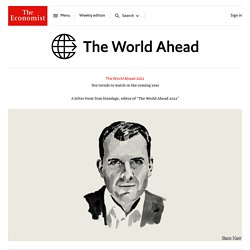
Here are ten themes and trends to watch in the year ahead. 1 Democracy v autocracy. Business Unusual: The Pandemic Forces a Social Reset. Topics Connecting With Customers in the Age of Acceleration The pandemic forced companies to speed digital transformation and adapt to a virtual world.
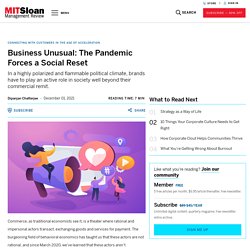
Customers are now rewarding those that offer the best experiences and engage authentically. To succeed in the next era, businesses and marketers must meet new expectations and build new strategies and skills. Your return-to-office announcements are missing the mark: Here’s how to get them right. October 25, 2021Communication is the key to success as leaders navigate the unsteady return-to-office phase.

We recommend that leaders have a thoughtful, open, and two-way dialogue with employees to help collectively shape the solution, but there’s more to it. While leaders are starting to have these conversations, we have also seen return-to-office announcements that entirely missed the mark. Many announcements to date have been rule based, inflexible, and have treated remote work as a perk, rather than a pandemic necessity that proved to be quite successful for many. 3 Strategies to Help Employees Thrive in the New “Normal” Great Resignation is speeding up: Here are 4 reasons why. Several months in, the Great Resignation continues to upend workforces across the country.
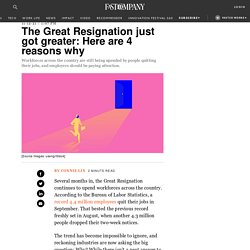
According to the Bureau of Labor Statistics, a record 4.4 million employees quit their jobs in September. That bested the previous record freshly set in August, when another 4.3 million people dropped their two-week notices. The trend has become impossible to ignore, and reckoning industries are now asking the big question: Why? Why the great resignation calls for some great re-engagement. It’s been 19 months and counting of Covid-induced change for huge numbers of workers across the globe.

Many are burnt out, others fed up. As their priorities evolve, businesses must re-evaluate how they engage employees. The stresses of juggling work and life, dealing with uncertain employment, accelerating business and digital transformations, working from home or not working from home, have created a great dislocation in the jobs market. And the numbers are stark. Getting Back to the Basics of Human Connection. While some of us may be eager to share our experiences with old and new coworkers when returning to the office, others may not be ready to talk about the emotionally searing experiences we’ve been through over the past year and a half....
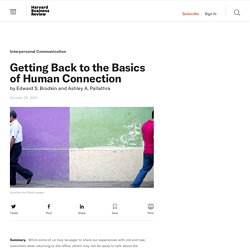
Returning to in-person work can be a tricky process that comes with a complicated mixture of feelings. Whether you’re excited or anxious about reentry, you can expect being around other people to require a lot of energy that you probably haven’t had to expend in a while. Why is in-person interaction such a drain, and how can you muster up the energy to reconnect with your colleagues? The CEO Agenda for the Postpandemic Era. Most CEOs were grounded in March 2020, right at the moment that their customers and employees needed them most.
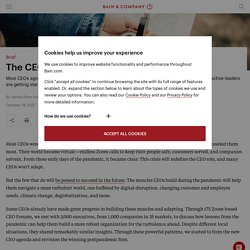
Their world became virtual—endless Zoom calls to keep their people safe, customers served, and companies solvent. From those early days of the pandemic, it became clear: This crisis will redefine the CEO role, and many CEOs won’t adapt. But the few that do will be poised to succeed in the future. The muscles CEOs build during the pandemic will help them navigate a more turbulent world, one buffeted by digital disruption, changing customer and employee needs, climate change, deglobalization, and more.
What to Do About “Back to the Office” Jitters. Ebook: Vaccines, Variants, and Back-to-Office Plans: 3 Crucial Conversations Skills to Alleviate Anxiety. What Will Matter Most When Screen Time Becomes Face Time Again? The hardest thing on earth is choosing what matters. – Sue Monk Kidd As many of us have been preparing to move from a virtual-first working model to a hybrid one, there's been much discussion about what we can't wait to get back once we can spend more time with colleagues and clients in person: hallway chats, after-work drinks, and eye contact.
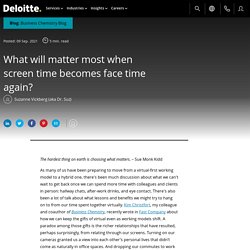
There's also been a lot of talk about what lessons and benefits we might try to hang on to from our time spent together virtually. Kim Christfort, my colleague and coauthor of Business Chemistry, recently wrote in Fast Company about how we can keep the gifts of virtual even as working models shift. What matters most? Five priorities for CEOs in the next normal. Special Report What matters most?

Five priorities for CEOs in the next normal Download this collection of insights on the five priorities global executives have told us they're focusing on as they navigate the trends shaping the future. Productive Workers Reshape APAC Business. How Asia’s businesses can make work more profitable and rewarding through “productive, anywhere” employees.
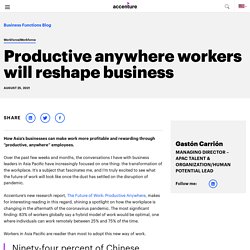
Over the past few weeks and months, the conversations I have with business leaders in Asia Pacific have increasingly focused on one thing: the transformation of the workplace. It’s a subject that fascinates me, and I’m truly excited to see what the future of work will look like once the dust has settled on the disruption of pandemic. Accenture’s new research report, The Future of Work: Productive Anywhere, makes for interesting reading in this regard, shining a spotlight on how the workplace is changing in the aftermath of the coronavirus pandemic. The most significant finding: 83% of workers globally say a hybrid model of work would be optimal, one where individuals can work remotely between 25% and 75% of the time.
New Report Reveals What Employees Will and Won't Tolerate at Work. After 18 months of uncertainty, stress, and adaptation on the job, employees know what they will and won't tolerate at work--and soaring resignation numbers are the result. That's the top-line finding of "The Great Resignation," Workhuman's fall 2021 international survey. Nearly 4 in 10 workers said they're planning to look for a new job in the coming year, a figure that should terrify workforce planners and managers alike. Labor Department data confirm this: Quit rates are up 25 percent since 2017, according to the Bureau of Labor Statistics, with a big jump coming in recent months. Many workers, having survived the worst recession and work disruptions of their lifetimes, are determined to improve their work situations, and the tight talent market gives them the opportunity and market clout to do so.
Rethinking the ways we look at productivity in a Work from Anywhere world - How to evaluate remote worker productivity post-pandemic. WfA Blog 4: Productivity The overnight shift to a remote workforce due to the pandemic (and the productivity realized) shed a light on the inadequacies in the way we look at and measure productivity. Early in the shift to mostly remote work, one of the primary concerns of organizations was how to maintain productivity in a digital workplace environment. There had been an entrenched orthodoxy that remote work hampered productivity, underscored by management concerns that productivity is harder to measure when you cannot physically see employees onsite in their offices and cubicles. However, the productivity gains realized over the pandemic imploded that orthodoxy. The future of work: Managing three risks of the hybrid workplace. July 19, 2021With the gradual reopening of nations around the world, organizations have been evaluating post-pandemic working models and the physical return to work.
The COVID-19 crisis forced many organizations, particularly those largely composed of knowledge workers, to shift to a remote model. Although there is much excitement over restoring some level of in-person interaction in the workplace, 68 percent of organizations do not yet have a clearly articulated vision or plan in place. Reinventing the Watercooler Effect: How virtual cross-company encounters can increase innovation in a hybrid world. And How to Get Them to Stay, According to a New Survey. Promises were made. At the outset of the pandemic, employers said they'd respect their worker's health and safety.
They also vowed to prioritize employee mental wellness. Yet nearly 19 months in, two-thirds of workers who are now looking to change jobs say their bosses have not followed through on at least one of these promises. Reimagining Your Organization in a Post-Pandemic World. By now, organizations across the globe are all too familiar with what has been deemed the “new normal.” The pandemic forced change and adaptation at a breakneck pace. Now, we are working in an environment that is part crisis-management, part mid-length sustainability stopgaps. There are obvious downsides of the current market state, such as revenue volatility and the idling of business development, but there are upsides, too. What You’re Getting Wrong About Burnout. The Next Normal Emerging stronger from the coronavirus pandemic.
What matters most? Five priorities for CEOs in the next normal. Making the Great Attrition the Great Attraction. Returning to the Office Isn’t Business as Usual. Podcast: How the Pandemic Changed Talent Management. Three Research-Backed Tips for Successfully Implementing a Hybrid Work Policy. Never going back to the office? Facebook has an app for that. The future of work: Seizing the opportunities of the new normal. Don’t Force People to Come Back to the Office Full Time. 100 Best Companies to Work For. Are You Ready for the "September Shuffle"? Your future work experience is Smart Work Anywhere. It’s Time to Re-Onboard Everyone. The Workforce Has Changed: Ensure Your Employees Are Prepared. The 'Great Resignation' Is Really the 'Great Discontent' Getting real about hybrid work. Returning to the Office Will Be Hard. Here’s How Managers Can Make It Easier.
Has the Delta Variant Disrupted Your Office Reopening Plans? The New World of Work is Here. Fostering a Culture of Belonging in the Hybrid Workplace. What’s In It for Me? How leaders can reframe failure in a post-pandemic world. Redefining employee performance for a post-COVID era. It’s Not All Sunshine and Roses. Voici comment apaiser les inquiétudes liées au retour au travail. How 15+ tech companies are transitioning back to the office (or not) Labor force in the post-COVID-19 world: Will they return? 4 Strategies for Building a Hybrid Workplace that Works. What remote work revealed about the role of onboarding. Taking Action Towards Your New Normal. 4 Pillars for a Productive Return to Work. Podcast: Serious Change in Return to Normal with Peter de Jager. Return as a muscle: How lessons from COVID-19 can shape a robust operating model for hybrid and beyond.
Forget getting back to “normal,” get back to profitable growth. A Guide to Designing Your New Normal – Mark Mullaly. New i4cp Survey: Despite Vaccinations, No Rebound for Business Travel. Should you quit your job and join the 'Great Resignation'? Getting real about hybrid work. Symptoms of the Delta Variant May Differ From the Original Strain. What That Means for Your Return to the Office. Building on the gains made from remote work. Ex-Google HR: Return to a hybrid office could be a disaster. Les employés non vaccinés bientôt victimes de ségrégation? 4 Ways To Make The Great Re-Entry Work For Your Employees. Why your COVID-19 exit needs ‘strategy inserts’ Prevent employee culture shock with a return to the office. LinkedIn by Crystal Taylor through Tim Creasey. How to Lead Your Team Through the Transition Back to the Office.
No one is returning to the office. A third of Americans plan to retire later due to Covid-19, study finds. Hybrid workplace considerations for a return to the office. Charting the path to the next normal. Reimagining the Office for Immensely Human Interactions. Charting the path to the next normal. How to Talk to Employees About Reopening. Survey: 2021 Return to Workplace. Why Companies Should Adopt a Hub-and-Spoke Work Model Post-Pandemic. The bosses who want us back in the office.
GM's 2-Word Plan for Returning to Work Is Vague, Ambiguous, Unclear, and Simply Brilliant. Why the return to work is a diversity issue. Don’t Let Employees Pick Their WFH Days. Hybrid work: A blueprint for designing a better workplace. What’s next for consumers, workers, and companies in the post-COVID-19 recovery. Going Back to Work in the Office: It Has to Be Worth It. Three post-pandemic predictions for the world of work. Resist Old Routines When Returning to the Office.
Google's 3-Word Plan for Returning to Work Is the Best I've Ever Seen. Is Your Boss's Return-to-Office Plan Safe? Here's How to Know. Leading Through the Big Transition to the New Reality. Leadership and the return to the office. Reboard Your Workforce With Your Culture in Mind. Organizing for the New Normal: Prepare Your Company for the Journey of Continuous Disruption (27 April 2021) by Constantinos C. Markides.
An injection of hope: Life after the COVID-19 vaccine. A “New Normal” for Leadership?: Where We Go From Here. The Hybrid Hitch. Travail à distance : 5 étapes pour favoriser l’intégration des nouveaux employés. Designing for adaptive work post COVID-19 (podcast)